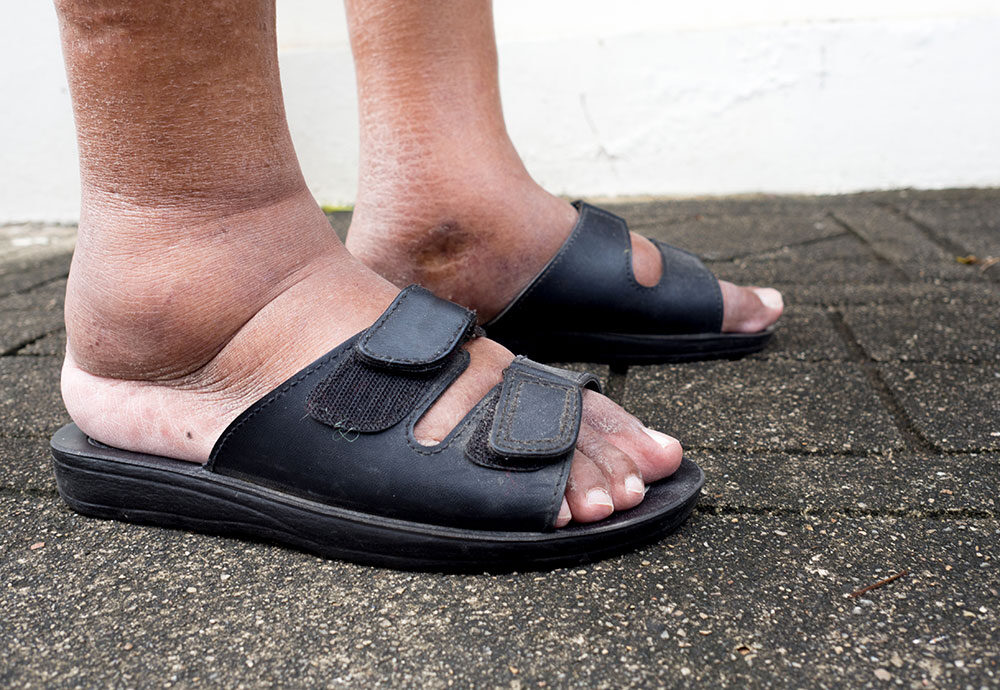If you have diabetes, you are at increased risk of foot problems and amputation. Therefore, it is very important that you check your feet; top, bottom, sides, between the toes, and toenails, at least once a day.
The best time to inspect your feet is after a bath or shower. When your feet are dry (including between the toes), sit in a well-lit room. If you have trouble seeing the bottom or sides of your feet, use a mirror with an extended handle or any mirror that permits you to see your whole foot.
Look and feel for:
- Bumps, lumps, blisters or bruises.
- Cuts, sores, or cracked skin. Even the tiniest crack can become infected.
- Patches of thin or shiny skin (which can signal lack of blood flow) or areas of redness (especially red streaks, which can signal the presence of infection).
- Temperature differences (one part warm, another cold). This can signal lack of blood flow.
- Pain, tingling, numbness or no feeling at all. These can signal nerve problems.
- Ingrown toenails with red, puffy skin along the nail and tenderness or pain.
- Loss of hair on foot or leg, which also can signal reduced blood flow.
If you have any of these signs or symptoms, seek medical care immediately. Your foot is at risk.
Foot self-care:
- In addition to doing daily foot inspections, see a foot care professional for regular foot examinations and preventive foot care.
- If you have numbness, tingling or loss of feeling in your feet, be extra cautious.
- Make sure there are no sharp objects such as broken glass, nails, or exposed sharp edges on floors or in carpeting.
- Never walk or move around barefoot, even inside your house.
- Wash feet daily using lukewarm, never hot, water. Use your elbow to test water temperature. After washing, dry feet thoroughly and keep them supple by applying lotion only to the tops and bottoms of the feet. Don’t apply lotion between the toes, since this can create a moist environment that favors fungal growth.
- Do not attempt to cut toenails if you have neuropathy or other foot problems related to diabetes. See a podiatrist or a foot care nurse regularly for toenail care and foot examinations. Never attempt to cut or file calluses or other protrusions on your feet.
- Never use wart removers or other harsh chemicals on your feet.
On your feet:
- IPFH suggests wearing only properly selected and fitted, as part of an integrated approach, padded socks with shoes with non-slip outsoles and any inserts or orthotics prescribed or recommended by a doctor or foot health professional. Peer-reviewed, published studies have shown that wearing clinically tested padded socks can help prevent injuries to the skin/soft tissue of the foot, a major cause of diabetic ulcerations.
- Padded Socks made from acrylic and acrylic blends have been demonstrated by clinical research to be best for the diabetic foot; 100% “natural” fibres (cotton, wool and silk) retain moisture and make feet vulnerable to irritation, lesions, athlete’s foot, blisters and other foot conditions.
- Don’t wear the same pair of shoes every day (if possible, rotate between at least two pairs). Change your padded socks daily—more often if you are active.
- Never depend on shoes to “fit better after they’re worn for a while.” Trust the foot health professional who analyzes your gait and sizes your feet. New footwear may “feel” large, but if all components are properly fitted as a system—padded socks, insert/orthotic, shoes they will provide better protection.
- Check inside shoes daily for sharp points, sharp edges, seams or other rough areas or foreign objects that may lead to cuts, wounds or abrasions on your feet.
- Don’t cross your legs for extended periods, as this can reduce blood flow and create pressure points. For the same reason, don’t sit for more than an hour or two without changing positions.
- Walk as much as possible; doing so enhances circulation to the feet and helps with weight and blood sugar control.



